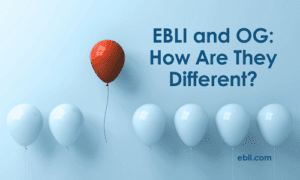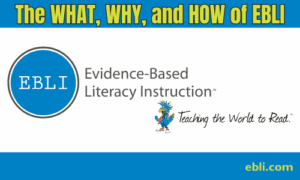What Makes EBLI Instruction Unique
When explaining EBLI to educators, administrators, and others, the most comment I get is “We already do that”.
Reflecting on their comments, I realize my weakness in conveying the unique, innovative qualities of EBLI that are hindering understanding. In collaborating with others who have created and/or teach a Structured Linguistic Literacy or Speech to Print approach, I’ve discovered that explaining why and how this approach is unique (without the opportunity to actually show instruction in action) is highly challenging for all of us!
My intention for this blog and the companion webinar is to provide clarity on how EBLI is revolutionary and different from other approaches to teaching reading.
David Chalk, a successful but significantly sub-literate entrepreneur, allowed his EBLI instruction to be filmed for The Truth About Reading documentary. He had been taught with a variety of different methodologies over the decades that were not effective. Here is his excellent explanation of how learning to read with EBLI was different than everything else he’d been taught:
“When I learned that English was a code based on what I already knew, which was the words I speak, everything opened up for me. I can say a word and then say each of the sounds in the word. Then spelling each sound with the letter or letters that were the code for the sound, and having support with that, opened up everything from a logical standpoint. If I could put that code down with letters for the sounds I say to spell a word, then I could pick the words back up off the whiteboard or page by saying the sounds and putting them back together into a word. It was brilliant and really so simple when I used to think there was no rhyme nor reason to how to read or spell and I just had to do my best to memorize it all.”
Some ways EBLI instruction is unique:
- Speech first for encoding and decoding
- Integrated
- Accelerated
- Scaffolded
- Comprehensive
- Geared toward decreasing cognitive load
- Incorporates explicit, systematic, foundational instruction in all areas of literacy:
- The 5 Essential Components of Reading
- Phonemic Awareness
- Phonics
- Vocabulary
- Fluency
- Comprehension
- Handwriting
- Spelling
- Writing
- The 5 Essential Components of Reading
- Organized to facilitate immediate, supported application of what was taught/learned via
- Reading in books and other connected text
- Writing
Starting from what a child or learner of any age knows- the words that they are already able to speak – is integral for both reading and spelling instruction. Accessing the whole word that they say, segmenting the word into sounds, matching the letter(s) or spellings to the sounds as they write them, then saying the sounds and blending the word back together: this is at the core of EBLI instruction. An emerging reader child or struggling older reader is buoyed and comforted by the realization that the words they speak are the impetus for learning to read or learning to read better. They already possess a fundamental piece of the learning to read process before instruction in the code even begins!
Active participation in instruction is engaging and multi-modal, with students seeing, saying, hearing, and writing during explicit instruction. Error correction is immediate and embedded into the activities taught, whether in whole class or intervention instruction. Instructional practices are intentional, with every step taught having a purpose. For example, ensuring students say the sounds as they write each spelling incorporates many essential components of reading, writing, and spelling. This practice also helps learners notice patterns as they occur in words and facilitates the orthographic mapping process. Educators can forgo teaching letter names and sounds in isolation, even with preschoolers, which simplifies instruction, accelerates learning, and frees up precious instructional time.
Teaching the code by words to sound and then matching the spelling avoids the need for instruction in phonics rules or syllable types. The amount of information needed and heavy cognitive load is dramatically decreased when teaching decoding with a Structured Linguistic Literacy system like EBLI. Leading with speech, instead of the letters or print, for both reading and spelling follows an approach that puts the focus on what is natural and automatic (speech) as opposed to what is man-made and awkward (print).
Leading with speech when reading is asking the learner to ‘pick up’ words off the page using the process they have been explicitly taught: English is a code and they will match sounds in words to the letters in print that represent them, with explicit instruction and support at first. They then become automatic at this process and use this process to accurately and automatically read and comprehend text.
Integrated instruction with EBLI is critical to the ease of both teaching and learning. Every activity incorporates many components of literacy as opposed to teaching them in isolation or in ‘silos’. For example, EBLI’s Multi-Syllable Split Word Reading activity incorporates phonemic awareness with letters (segmenting, blending, phoneme substitution), phonics, vocabulary, and fluency as well as morphology instruction. It also includes cognitive training processes to strengthen memory, processing speed, sequencing, timing, rhythm, focus, and attention. Words that are learned in this activity are pulled from stories or texts that the students will then read, which improves both fluency and comprehension.
If a child is speaking multi-syllable words and has been taught the Structured Linguistic Literacy process through EBLI skills, concepts, and activities, then they will quickly be able to read and spell multi-syllable words. This is true even for the youngest emerging reader.
Reading and spelling utilize the same code. A reader is picking up the code off the page and a speller uses the same code to put words down on a page. Spelling is much more challenging to learn as English is a complex code, with many spellings or graphemes used to spell the same sound and often the same grapheme or spelling represents different sounds. A firm knowledge of the alphabetic code and the concepts that make it complex is crucial in order to become an automatic, accurate reader and speller.
The human brain is a pattern seeking machine! Fortunately, the English alphabetic code is chock full of patterns. Because of this, when a learner is explicitly taught the concepts unique to English and learns how to apply it with instruction that incorporates the patterns, their brain learns the concepts quickly and easily. Not only that, they can then apply these concepts to code that they have not even been explicitly taught! Because of this, the process is what is most important, not the material (you’ll get examples of what I mean by this in the companion webinar). We don’t have to teach all or even the majority of the spellings for all the sounds or all the patterns. This initial direct, explicit instruction that is interleaved with spaced repetition and application, results in faster, further student progress with no need to put focus on mastery! Students will master the code, in reading and spelling, by applying the skills, concepts, and information through supported reading in text and writing. This is another reason for the accelerated student progress with EBLI.
With reading, like with building a house or car, the end goal is to get it taught or built so it can be used for what it was intended for – to enjoy it! It is imperative to include all of the components in the teaching or building in the most efficient way to get the best possible outcome at the end.
With EBLI, the Speech to Print/Structured Linguistic Literacy approach or methodology used is intended to get students there as effectively and efficiently as possible and to provide teachers, private interventionists, and parents with what they need to get them there!






1 Comment
Listening to the video and reading the different articles was most enlightening. Thank you for sharing information so that I can meet the needs of my students as issues arise throughout the EBLI process.
Comments are closed.